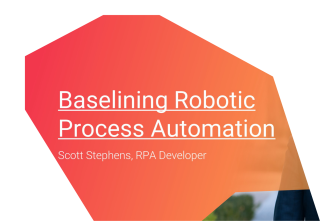Baselining Robotic Process Automation

Robotic Process Automation (RPA) is on the rise with demand for RPA solutions increasing rapidly across all sectors. As with other change waves, the understanding of what RPA is has not followed the same upward trajectory.
Often approached from the lanes of process improvement, modernisation, or digital innovation, there is a danger that RPA capabilities are developed without a functional understanding.
What is and is not RPA?
RPA technologies automate manual system interactions that have typically been undertaken by a human user. The common misunderstandings come from how. Perhaps the most important concept to understand upfront regarding RPA, is that it mimics user inputs. RPA developers are not coding complex solutions which fundamentally change how a given application works. They are “programming” RPA bots to undertake the same mouse clicks and keystrokes as a human user. The difference being that an RPA bot can do those tasks at lightning speed, with perfect accuracy, 24 hours a day.
At its core an RPA solution replicates user inputs, it is certainly not just a “big macro”. Desktop recording automation tools certainly exist (software which literally records a human user undertaking task and then plays back their mouse and keyboard inputs), but do not represent RPA. Recording based solutions provide virtually zero robustness. They are derailed from their task and process by the simplest of interruptions (imagine for example a pop up window appearing unexpectedly). In these cases the recordings keep clicking away, totally unaware they are no longer clicking on the right things.
RPA provides the solution to this problem. RPA bots constantly determine where they are, and what is and is not present in their digital environment. Because of this, they avoid immediately derailing at the first sign of change. A well designed RPA bot will check for the element its wants to use and determine if it is there. It will also check that each of its actions is really desired and take action to get things back on track if goes wrong.
So RPA is AI?
That… is complicated. The core technology basis for RPA is not Artificial Intelligence. There is nothing “intelligent” about an RPA bot following its process rules and executing tasks. Of course, the tasks themselves can be large and complex, with many, many variations and deviations, but at its centre, the bot is never undertaking an intelligent decision. Rather it selects from a set of options, based on criteria and rules.
However, Intelligent RPA Automation is absolutely a capability that exists and is expanding in scope. Intelligent Automation begins to close the gap between hard and fast rules with clear information, and ambiguous tasks. Take for example bots used for accounts receivable or payable. Of course, the majority of the intended bot work follows simple rules. Receive an invoice via email. Save it. Log in to accounting software. Add the details. Generate an invoice, etc. But how do we set hard and fast rules for the template structure of every possible invoice a client may receive? How do I teach the bot to recognise the fields of an invoice when those fields constantly change position, size, font, title etc. Here intelligent support comes in to play. Using either in house development, or third-party technology partners (depending on your RPA vendor of choice) other technology is integrated into RPA. In the example here, by adding a software capability that can read a scan of an invoice and determine where the required fields are, even on a new format it hasn’t seen before. Once known, the regular RPA bot can do the rest of the work.
So RPA has nothing to do with AI?
That… is also complicated. While basic RPA bots are not AI, and neither are “intelligent” plug-in services truly AI, bringing RPA into your workforce is often a first step along the “AI Pathway” for an organisation. It is an easily consumable first progression up a technology tree with many steps, that may ultimately end in the integration of real AI technologies.
However, it would not be accurate to say RPA has no interaction with AI at all. In the same way intelligent automations can leverage plug-in technology services to undertake more dynamic tasks, so to can true AI services integrate with a RPA bot. Services such as Google AI or IBM’s WATSON can be called out to by a RPA bot to answer a specific query or clarify information. While these services are not widespread at the implementation level, they are very real. A commonly cited example is a background checking bot, using AI services to conduct facial recognition tasks. As with intelligent automation, the RPA bot does the grunt work of repetitive, rules based tasks while the additional AI service provides a more advanced input when required.
So RPA is coming?
RPA is here. The implementation of RPA solutions is real, ongoing and rapidly expanding. Workforce planning teams are rightly preparing for this new mode of workforce implementation, with many advisors tailoring their services to understand how teams will work with integrated bot workers. Real work is being done now across every industry, and it likely isn’t the visible work components. Your Financial Auditors Report may not have been written by a bot, but the invoicing for the service may have been. In fact, it may have been a bot which scanned various systems to find the tender for your work and informed the auditor they should bid. As comfort and exposure to the technology increases, so too will its prevalence – but in some cases the requirement to manage increasing workloads with decreasing resources (“doing more with less”) will demand that RPA bots are integrated now; ready or not.
Scott is a Lead RPA Developer for Synergy Group
